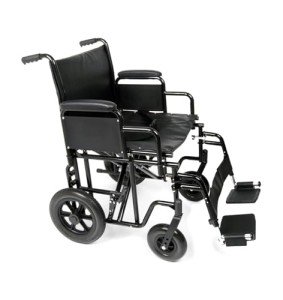inquiry
Having the proper seat width is very important to wheelchair users who invest longer durations in their chairs. Too narrow a seat will trigger pressure on the hips and thighs which could result in sores or pressure points. Having too broad a seat can also make it hard for the user to reach the hand rims to move themselves or maneuver in little spaces.
To determine the correct seat width a person would sit on a chair typically and have their measurement taken throughout their lap at the largest point which is usually their hips. A wheelchair measuring tape can be utilized to determine this, but a yard stick is chosen as it prevents individuals from covering the tape around their hips which would offer an inaccurate outcome.
The standard wheelchair seat width is 16" (narrow grownup), 18" (basic adult), and 20" (broad grownup). For bariatric patients, a 24" seat is readily available. This sturdy additional wide bariatric wheelchair from Medline features swing-away footrests, a carbon steel frame with rust- and chip-resistant chrome plating, and easy-to-clean vinyl upholstery. It has a weight capacity of 500 pounds.
Seat Depth
Typically, the seat depth of a bariatric wheelchair was added 2" to the measurement taken at the user's largest point (normally their hips). This was meant to accommodate additional layers of clothing that may be worn during cold weather. However, this practice is ending up being less typical as wheelchair users are able to spend more time indoors and are not wearing long coats. This makes the seat depth of a chair less essential when choosing a bariatric wheelchair. Nevertheless, it is still crucial to choose an option that provides appropriate support for larger users.
The Medline folding additional broad bariatric manual wheelchair includes a comfortable 24" seat width and a durable slide tube silver vein frame. It likewise has an adjustable axle and tool-free elevating legrests.
Seat Height
When it comes to determining the right wheelchair seat width you must always determine from the user's widest point which is typically their hips. You will also need to consider whether the user is going to be wearing a winter season coat as this may add 2" to the width required.

When other is in usage it ought to only be operated on level surfaces with the wheel locks totally engaged. This is to prevent the chair from having the ability to move slopes that are 10 degrees or higher. It is also important to remember that any activity that might move the center of gravity in the chair need to be done with care. This includes reaching for items that need the individual to lean out of their seat or trying to stand from it.
Whenever you have the chair in use it is advised that you regularly inspect it for damage and lubricate any areas that are deemed required. For instance, the casters must be lubed by getting rid of the caster fork and utilizing a multi-purpose grease to use to the caster stem bearings. Also, the foot plates can be changed by loosening up the bolt and then moving them to the desired position. This allows the feet to sit easily on the footplate and avoids any pressure points from forming. This can be very unpleasant for the user and if left unattended, can lead to press sores.
Weight Capacity
Bariatric wheelchairs are created to support more weight than basic wheelchairs. This makes them stronger and better geared up to deal with falls. They are likewise typically bigger and broader, making them less maneuverable in tight spaces than standard wheelchairs. They require cars with special ramps and lifts to pack them, in addition to drivers who understand how to finest transport them from one place to the next.
When choosing a wheelchair, consider its weight capacity as it will be the primary determining consider whether it will accommodate your passenger's requirements. The weight capacity of the chair is often listed as a static load, meaning that it shows the amount of weight the chair can conveniently hold while stalling. However, some producers likewise note an active load that is based upon a drop test and can imitate the result of somebody sitting down in the chair. This may be a more reputable measurement of the weight limit, depending on your needs.
If you prepare to carry out activities that move your center of gravity in the seat (such as grabbing things), make certain to have front casters pointed in a forward instructions and wheel locks engaged so the chair will not tip over. Likewise, inspect that casters are oiled routinely to prevent excessive wear and abrasions. The lubrication procedure includes eliminating the fork, separating the caster from the wheel, and greasing the caster stem bearings with top quality multi-purpose grease.
